Abstract
We have investigated the morphological differences responsible for the variability in two tests of pulmonary function, maximal expiratory flow rates (MEF) and the frequency dependence of dynamic compliance (CDYN ratio). Functional measurements were obtained from 53 normal and minimally diseased postmortem human lungs. Morphological measurements performed on these same lungs included airway diameter at three levels in the bronchial tree, the amount of bronchial gland mass, and the alveolar surface to volume ratio. Multiple regression analysis suggests that the diameter of the peripheral conduction airways (membranous bronchioles) is the major morphological determinant for both MEF and the CDYN ratio in lungs at any particular age. Age-dependent changes in both functional tests were associated primarily with differences in the alveolar surface to volume ratio. Minimal emphysema and a lesion associated with cigarette smoking, respiratory bronchiolitis, have no demonstrable effect on either MEF or the CDYN ratio. These studies provide further evidence that the peripheral conducting airways are a major determinant of ventilatory function in the normal human lung.
Full text
PDF
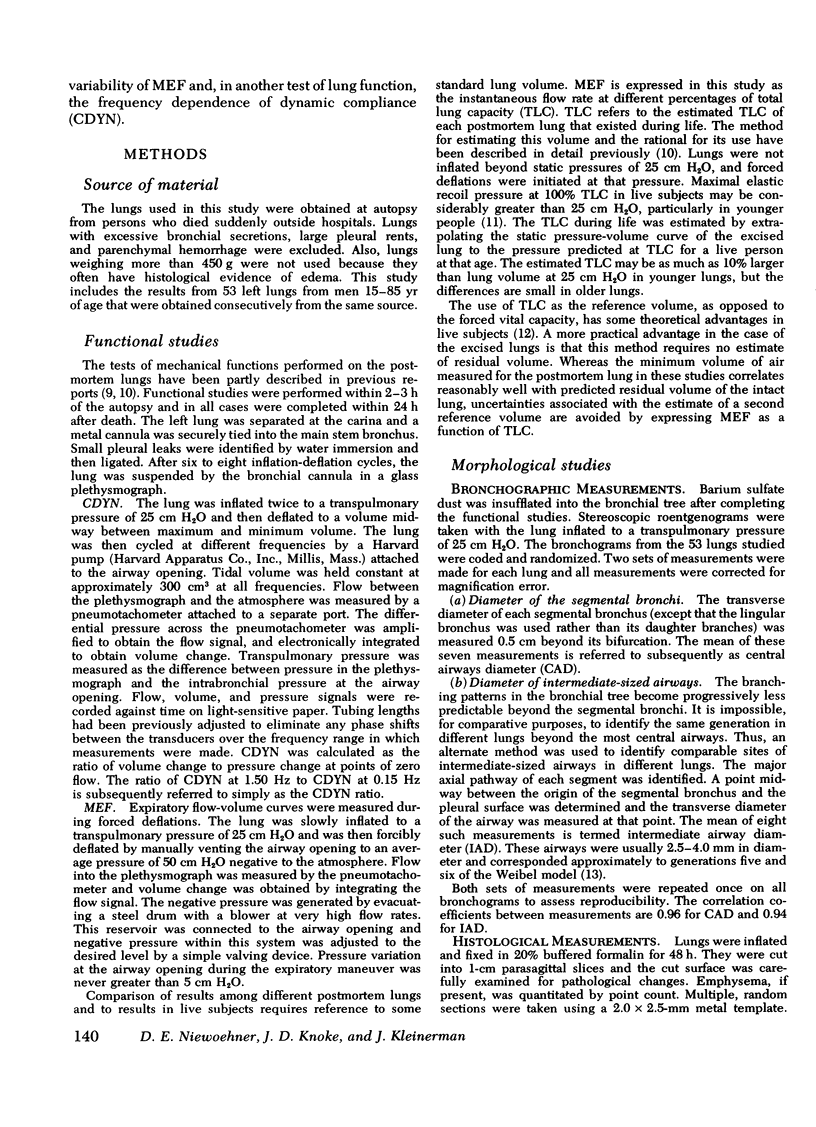
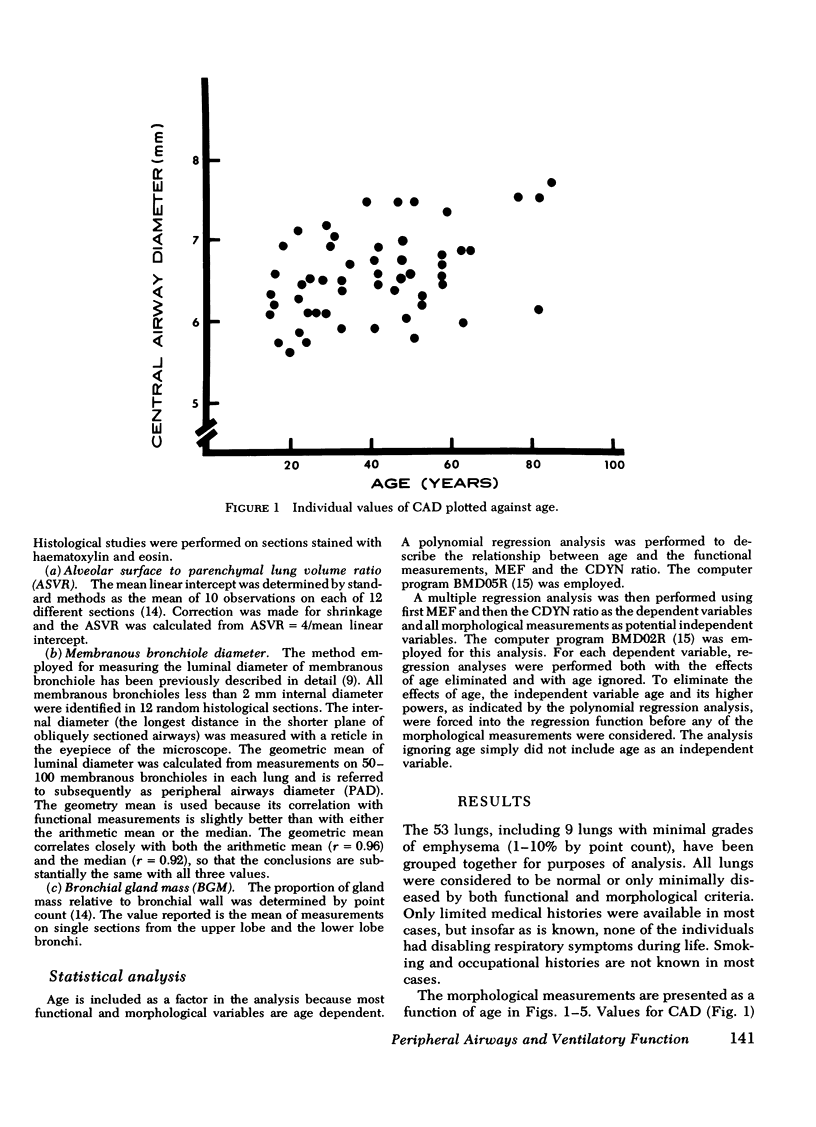
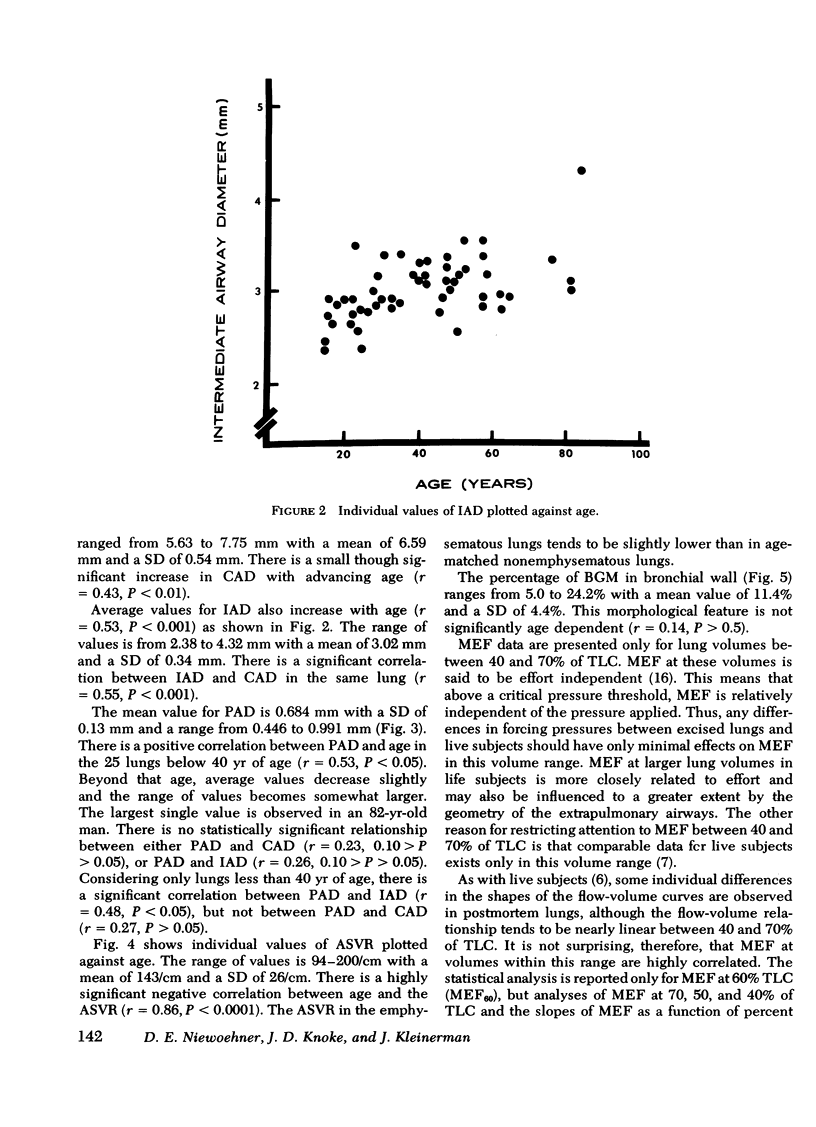


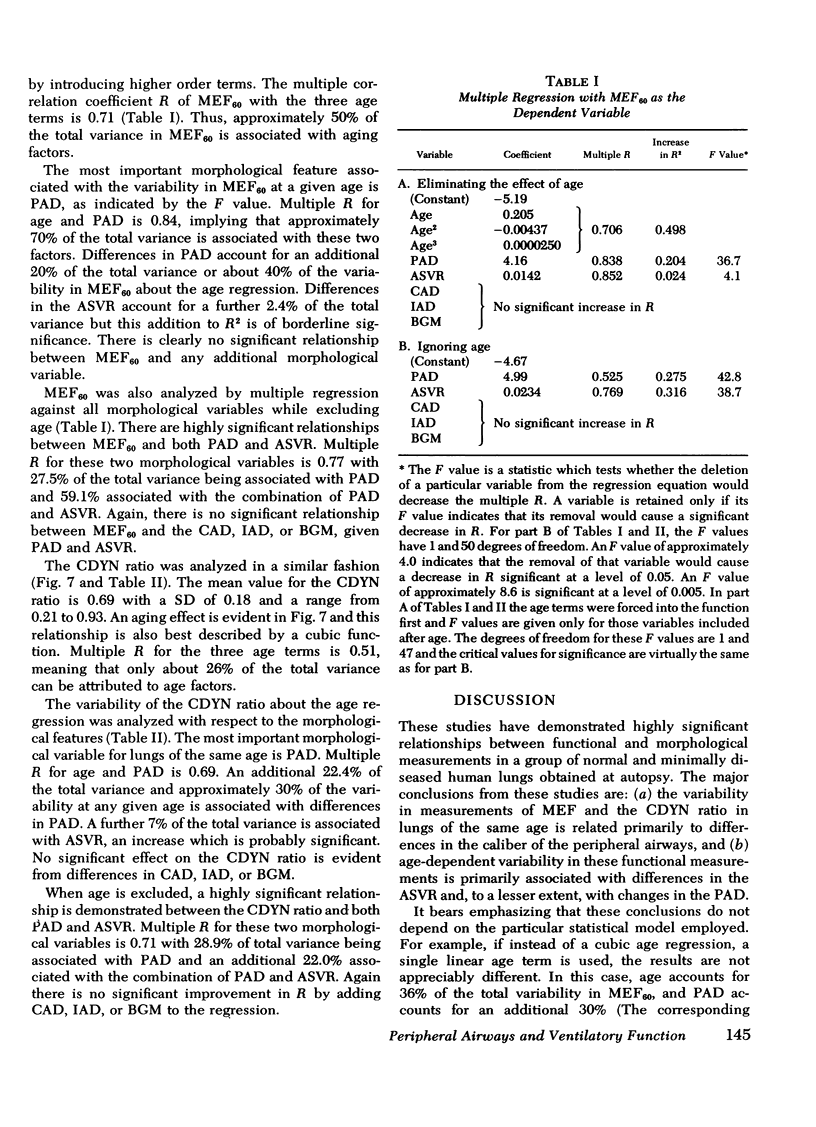





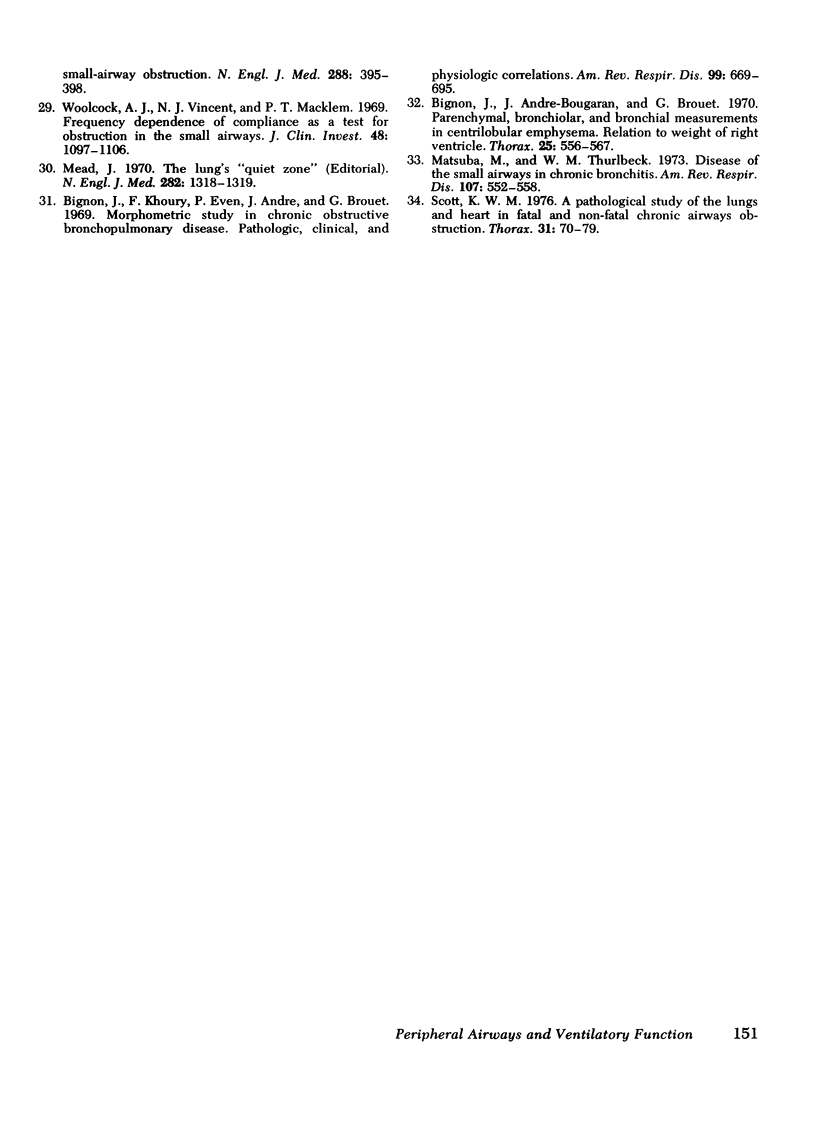
Selected References
These references are in PubMed. This may not be the complete list of references from this article.
- BIRATH G., KJELLMER I., SANDQVIST L. Spirometric studies in normal subjects. II. Ventilatory capacity tests in adults. Acta Med Scand. 1963 Feb;173:193–198. [PubMed] [Google Scholar]
- Bass H. The flow volume loop: normal standards and abnormalities in chronic obstructive pulmonary disease. Chest. 1973 Feb;63(2):171–176. doi: 10.1378/chest.63.2.171. [DOI] [PubMed] [Google Scholar]
- Begin R., Renzetti A. D., Jr, Bigler A. H., Watanabe S. Flow and age dependence of airway closure and dynamic compliance. J Appl Physiol. 1975 Feb;38(2):199–207. doi: 10.1152/jappl.1975.38.2.199. [DOI] [PubMed] [Google Scholar]
- Bignon J., Andre-Bougaran J., Brouet G. Parenchymal, bronchiolar, and bronchial measurements in centrilobular emphysema. Relation to weight of right ventricle. Thorax. 1970 Sep;25(5):556–567. doi: 10.1136/thx.25.5.556. [DOI] [PMC free article] [PubMed] [Google Scholar]
- Bignon J., Khoury F., Even P., Andre J., Brouet G. Morphometric study in chronic obstructive bronchopulmonary disease. Pathologic, clinical, and physiologic correlations. Am Rev Respir Dis. 1969 May;99(5):669–695. doi: 10.1164/arrd.1969.99.5.669. [DOI] [PubMed] [Google Scholar]
- Black L. F., Offord K., Hyatt R. E. Variability in the maximal expiratory flow volume curve in asymptomatic smokers and in nonsmokers. Am Rev Respir Dis. 1974 Sep;110(3):282–292. doi: 10.1164/arrd.1974.110.3.282. [DOI] [PubMed] [Google Scholar]
- Bouhuys A., Hunt V. R., Kim B. M., Zapletal A. Maximum expiratory flow rates in induced bronchoconstriction in man. J Clin Invest. 1969 Jun;48(6):1159–1168. doi: 10.1172/JCI106073. [DOI] [PMC free article] [PubMed] [Google Scholar]
- Cherniack R. M., Raber M. B. Normal standards for ventilatory function using an automated wedge spirometer. Am Rev Respir Dis. 1972 Jul;106(1):38–46. doi: 10.1164/arrd.1972.106.1.38. [DOI] [PubMed] [Google Scholar]
- Gelb A. F., Zamel N. Simplified diagnosis of small-airway obstruction. N Engl J Med. 1973 Feb 22;288(8):395–398. doi: 10.1056/NEJM197302222880805. [DOI] [PubMed] [Google Scholar]
- Green M., Mead J., Turner J. M. Variability of maximum expiratory flow-volume curves. J Appl Physiol. 1974 Jul;37(1):67–74. doi: 10.1152/jappl.1974.37.1.67. [DOI] [PubMed] [Google Scholar]
- Guyatt A. R., Siddorn J. A., Brash H. M., Flenley D. C. Reproducibility of dynamic compliance and flow-volume curves in normal man. J Appl Physiol. 1975 Sep;39(3):341–348. doi: 10.1152/jappl.1975.39.3.341. [DOI] [PubMed] [Google Scholar]
- HYATT R. E., SCHILDER D. P., FRY D. L. Relationship between maximum expiratory flow and degree of lung inflation. J Appl Physiol. 1958 Nov;13(3):331–336. doi: 10.1152/jappl.1958.13.3.331. [DOI] [PubMed] [Google Scholar]
- Hogg J. C., Macklem P. T., Thurlbeck W. M. Site and nature of airway obstruction in chronic obstructive lung disease. N Engl J Med. 1968 Jun 20;278(25):1355–1360. doi: 10.1056/NEJM196806202782501. [DOI] [PubMed] [Google Scholar]
- KORY R. C., CALLAHAN R., BOREN H. G., SYNER J. C. The Veterans Administration-Army cooperative study of pulmonary function. I. Clinical spirometry in normal men. Am J Med. 1961 Feb;30:243–258. doi: 10.1016/0002-9343(61)90096-1. [DOI] [PubMed] [Google Scholar]
- Knudson R. J., Slatin R. C., Lebowitz M. D., Burrows B. The maximal expiratory flow-volume curve. Normal standards, variability, and effects of age. Am Rev Respir Dis. 1976 May;113(5):587–600. doi: 10.1164/arrd.1976.113.5.587. [DOI] [PubMed] [Google Scholar]
- Matsuba K., Thurlbeck W. M. Disease of the small airways in chronic bronchitis. Am Rev Respir Dis. 1973 Apr;107(4):552–558. doi: 10.1164/arrd.1973.107.4.552. [DOI] [PubMed] [Google Scholar]
- McFadden E. R., Jr, Kiker R., Holmes B., DeGroot W. J. Small airway disease. An assessment of the tests of peripheral airway function. Am J Med. 1974 Aug;57(2):171–182. doi: 10.1016/0002-9343(74)90441-0. [DOI] [PubMed] [Google Scholar]
- McFadden E. R., Jr, Linden D. A. A reduction in maximum mid-expiratory flow rate. A spirographic manifestation of small airway disease. Am J Med. 1972 Jun;52(6):725–737. doi: 10.1016/0002-9343(72)90078-2. [DOI] [PubMed] [Google Scholar]
- Mead J. The lung's "quiet zone". N Engl J Med. 1970 Jun 4;282(23):1318–1319. doi: 10.1056/NEJM197006042822311. [DOI] [PubMed] [Google Scholar]
- Mead J., Turner J. M., Macklem P. T., Little J. B. Significance of the relationship between lung recoil and maximum expiratory flow. J Appl Physiol. 1967 Jan;22(1):95–108. doi: 10.1152/jappl.1967.22.1.95. [DOI] [PubMed] [Google Scholar]
- Morris J. F., Koski A., Johnson L. C. Spirometric standards for healthy nonsmoking adults. Am Rev Respir Dis. 1971 Jan;103(1):57–67. doi: 10.1164/arrd.1971.103.1.57. [DOI] [PubMed] [Google Scholar]
- Niewoehner D. E., Kleinerman J. Effects of experimental emphysema and bronchiolitis on lung mechanics and morphometry. J Appl Physiol. 1973 Jul;35(1):25–31. doi: 10.1152/jappl.1973.35.1.25. [DOI] [PubMed] [Google Scholar]
- Niewoehner D. E., Kleinerman J., Liotta L. Elastic behavior of postmortem human lungs: effects of aging and mild emphysema. J Appl Physiol. 1975 Dec;39(6):943–949. doi: 10.1152/jappl.1975.39.6.943. [DOI] [PubMed] [Google Scholar]
- Niewoehner D. E., Kleinerman J. Morphologic basis of pulmonary resistance in the human lung and effects of aging. J Appl Physiol. 1974 Apr;36(4):412–418. doi: 10.1152/jappl.1974.36.4.412. [DOI] [PubMed] [Google Scholar]
- Niewoehner D. E., Kleinerman J., Rice D. B. Pathologic changes in the peripheral airways of young cigarette smokers. N Engl J Med. 1974 Oct 10;291(15):755–758. doi: 10.1056/NEJM197410102911503. [DOI] [PubMed] [Google Scholar]
- OTIS A. B., MCKERROW C. B., BARTLETT R. A., MEAD J., MCILROY M. B., SELVER-STONE N. J., RADFORD E. P., Jr Mechanical factors in distribution of pulmonary ventilation. J Appl Physiol. 1956 Jan;8(4):427–443. doi: 10.1152/jappl.1956.8.4.427. [DOI] [PubMed] [Google Scholar]
- Pardaens J., Van de Woestijne K. P., Clément J. A physical model of expiration. J Appl Physiol. 1972 Oct;33(4):479–490. doi: 10.1152/jappl.1972.33.4.479. [DOI] [PubMed] [Google Scholar]
- Scott K. W. A PATHOLOGICAL study of the lungs and heart in fatal and non-fatal chronic airways obstruction. Thorax. 1976 Feb;31(1):70–79. doi: 10.1136/thx.31.1.70. [DOI] [PMC free article] [PubMed] [Google Scholar]
- Turner J. M., Mead J., Wohl M. E. Elasticity of human lungs in relation to age. J Appl Physiol. 1968 Dec;25(6):664–671. doi: 10.1152/jappl.1968.25.6.664. [DOI] [PubMed] [Google Scholar]
- Woolcock A. J., Vincent N. J., Macklem P. T. Frequency dependence of compliance as a test for obstruction in the small airways. J Clin Invest. 1969 Jun;48(6):1097–1106. doi: 10.1172/JCI106066. [DOI] [PMC free article] [PubMed] [Google Scholar]
- van de Woestijne K. P. Spécificité des tests proposés pour le dépistage de la maladie des petites voies aériennes. Bull Eur Physiopathol Respir. 1976 May-Jun;12(3):477–486. [PubMed] [Google Scholar]


